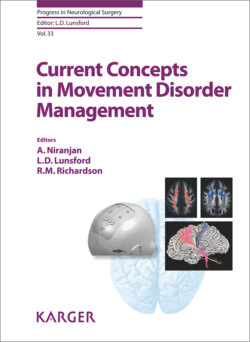Читать книгу Current Concepts in Movement Disorder Management - Группа авторов - Страница 19
The Era of Radiosurgery
ОглавлениеAlthough Leksell and his mentors Spiegel and Wycis both worked on the development of stereotactic guiding devices to implant radioactive phosphorus in cystic craniopharyngiomas, Leksell became convinced that cross-fired X-ray beams could be used to target a deep brain structure without making a surgical incision. He defined the term “stereotactic radiosurgery” in a published article in 1951 and described the treatment of 2 initial patients who had trigeminal neuralgia [24]. Working in the 1960s with his colleague Borje Larsson in Uppsala, Leksell described the usage of cross-fired proton beams to create lesions within the brain (Fig. 2). First animal models (usually goats) were used [25](Fig. 3). However, eventually a patient with chronic pain and a patient with a movement disorder became the first 2 patients to be treated using this technique. Comprehensive post mortem studies in both cats and goats demonstrated that highly defined and sharply demarcated lesions in the brain could be created using cross fired radiation beams.
Fig. 2. Professor Borje Larsson and Professor Lars Leksell using the Uppsala cyclotron to perform stereotactic radiosurgery. Proton beams were cross fired using the arc centered principle of the Leksell frame (Photo courtesy of Dr. Dan Leksell).
Fig. 3. Additional radiobiological studies using protons were performed using goats. After the procedure, the goats lived on Larsson’s farm until they died of natural causes. Autopsies showed the expected small deep brain lesion.
Fig. 4. The first prototype Leksell Gamma unit was installed at the Sophiahemmet in Stockholm in 1968, permitting Leksell to perform functional radiosurgery in the hospital environment (Photo courtesy of Dr. Dan Leksell).
Leksell and Larsson became convinced that the patient transportation and imaging complexities in the use of protons were clinically prohibitive. This concern led to the development of a self-contained stereotactic radiosurgical device termed the gamma unit, which was installed at a private hospital in Stockholm. The first Leksell gamma unit contained 179 cobalt 60 sources that delivered photon radiation via a secondary collimator helmet (Fig. 4). The lesion was created by a radiation knife (strǻlkniven in Swedish). Leksell and his team cautiously used the “Gamma Knife” to treat a small group of patients with movement disorders or severe anxiety or OCD disorders. The secondary collimator used to focus the beams had a narrow slit and created a discoid-shaped lesion suitable for interruption of tracts (in the case of obsessive or anxiety disorders) or creating lesions (in the case of thalamic surgery). Application of this radical concept confirmed that lesions could be created in the brain without a surgical incision. A second generation gamma unit was placed into clinical service in 1975, a device with a circular collimator port that created a more oblate spheroid lesion. In the early 1980s, 2 additional prototype devices were installed in Buenos Aires and Sheffield, England. In 1987, the fifth Gamma Knife was installed at the University of Pittsburgh Medical Center. This device contained 201 sources and facilitated larger targets, using secondary collimators that included 4, 8, 14, and 18 mm helmets [26].
The success of the stereotactic radiosurgical approaches for the treatment of movement disorders, which was not associated with the need to leave implanted electrodes or do battery changes, has led to the reevaluation of its role in movement disorder surgery, especially medically refractory essential tremor and Parkinson’s disease. Unilateral lesions are placed by Gamma Knife radiosurgery, typically using a 130 Gy maximum dose delivered by a 4 mm collimator. The technology results in the creation of discrete lesions in the thalamus, now targeted by an intraoperative MRI scan. Prominent centers in France (Regis) [27] and Japan (Ohye) [28] began to evaluate and compare both open as well as radiosurgical methods to perform lesional surgery for movement disorders. Worldwide, more than 450 patients have undergone thalamic radiosurgery using the Leksell Gamma Knife.
